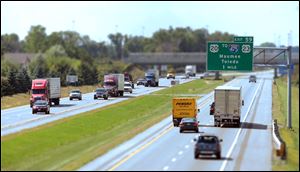
Turnpike toll
7/24/2013
Cars head east and west on the Ohio Turnpike near Maumee.
Gov. John Kasich argues credibly that the ambitious highway construction proposal he announced this week will create 65,000 jobs, promote economic growth, save money, enhance traffic safety, reduce time-wasting congestion, and improve public infrastructure across the state, including northwest Ohio.
But the plan is based on a big — and still questionable — bet: that the Ohio Turnpike will generate enough revenue to subsidize roadwork away from the turnpike corridor without unfairly burdening the toll road’s users or shortchanging the northern Ohio communities, Toledo among them, that lie along its 241-mile route.
RELATED: Police aim to make Turnpike safer
That premise remains to be proved or disproved, although the 2.7 percent toll increase approved last week for most turnpike users — likely the first of 10 such yearly hikes to help finance the plan — invites a degree of skepticism. State lawmakers of both parties who represent this region will need to remain vigilant to ensure its interests are protected.
The Kasich administration plans to borrow $1.5 billion by selling bonds backed by turnpike toll revenue, which will attract a matching amount of federal and local aid. That $3 billion will largely pay for 41 road and bridge projects, many of which have languished for years — and otherwise, state transportation officials say, would be delayed for many more — because of a lack of funding.
Among the projects in northwest Ohio: reconstruction of the Interstate 75/I-475 interchange in Toledo; a rebuilt interchange at I-475 and U.S. Route 20 (Central Avenue) in Sylvania Township; rebuilding, widening, and addition of a third lane on I-75 in Wood County; similar I-75 work from Phillips Avenue to I-280 in Toledo; a rail grade separation on McCord Road in Springfield Township; I-75 rebuilding in Hancock County, and upgrades to U.S. Route 250 in Erie County.
Construction on these projects is scheduled to begin next year or in 2015. This is necessary work, and local business leaders agree that the projects will strengthen northwest Ohio’s economy and infrastructure. But it will provide no excuse for skimping on turnpike maintenance, or indirectly encouraging heavy-truck traffic to abandon the turnpike in favor of non-toll roads.
Projects in other parts of the state may be funded from turnpike revenues if they demonstrate a “nexus” with the toll road, but it remains to be seen how that case will be made. Still, Mr. Kasich touts his proposal as an “innovative” alternative to waiting for more infrastructure money from Washington — likely a futile task, given the budget impasse in Congress.
But a modest increase in Ohio’s 28-cent-a-gallon motor-fuel tax, which has not risen in eight years, remains a better and fairer way to apportion the cost of road maintenance and repairs among those who benefit from them most. The governor and state lawmakers will not hear of a gas-tax increase, which they label a job killer.
The state Transportation Review Advisory Council is expected to give initial approval to the governor’s road plan on Thursday, but that’s the easy part. The tougher task will be to make sure that the motorists — and communities — that rely on the turnpike are protected.